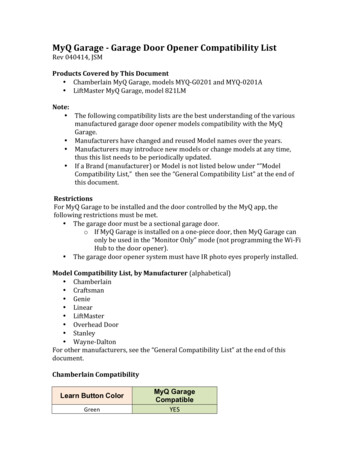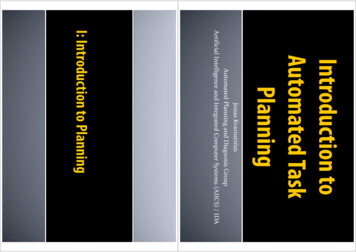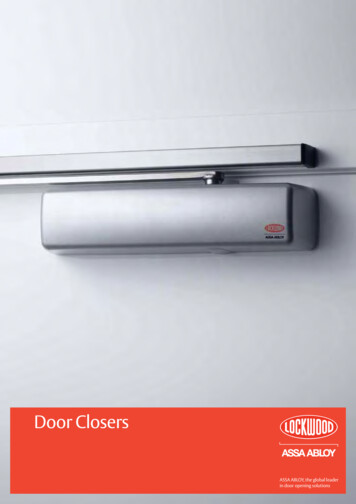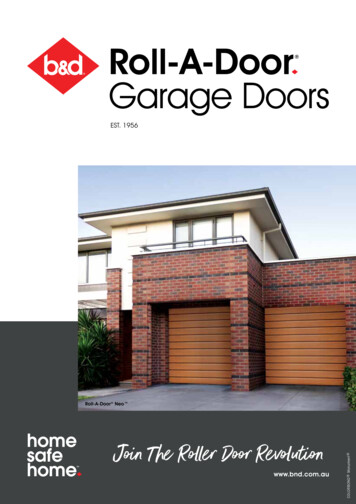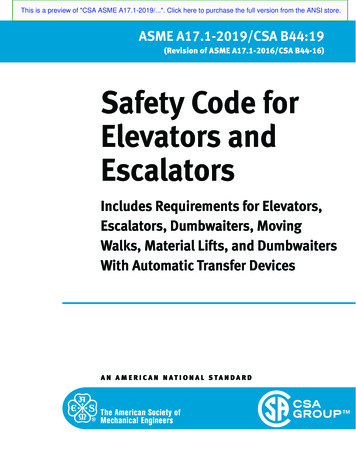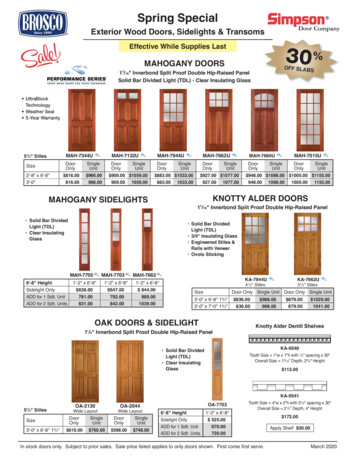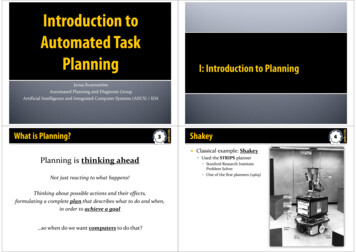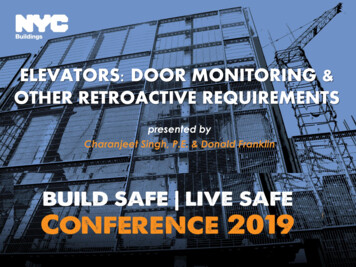
Transcription
ELEVATORS: DOOR MONITORING &OTHER RETROACTIVE REQUIREMENTSpresented byCharanjeet Singh, P.E. & Donald Franklin
COPYRIGHT MATERIALSThis presentation is protected by US and InternationalCopyright laws. Reproduction, distribution, display and useof the presentation without written permission of theDepartment is prohibited.The information in this presentation is current only as of thecopyright date of this presentation. This presentation is nota substitute for any law, rule or regulation. The Citydisclaims any liability for errors that may be containedherein and shall not be responsible for any damages,consequential or actual, arising out of or in connectionwith the use of this information. 2019 New York City Department of Buildings2
DESCRIPTIONThis presentation will provide an overview of NYCBCAppendix K, Chapter K3 which outlines retroactiverequirements for existing elevators including doorlock monitoring. ANSI A10.4 will be discussedinforming attendees about requirements for addingextensions to personnel hoists. Additionallyattendees will learn about various safety issuesarising from maintaining and working on conveyingdevices.3
LEARNING OBJECTIVESAt the end of this presentation, you will be able to:1. Participants will examine NYCBC Appendix K ChapterK3 to identify retroactive requirements for existingelevators including door lock monitoring requirements.2. Participants will discuss ANSI A10.4 and be able tosummarize requirements for Personnel Hoist cabextensions.3. Participants will be able to list requirements for loadweighing devices on passenger and freight elevators.4. Participants will analyze common causes of minorelevator/escalator accidents and remedies.4
OVERVIEW:ELEVATORS IN NEW YORK CITY37 million trips basedon number ofpassenger elevatorsin the City
OVERVIEW:ELEVATORS IN NEW YORK CITYApproximately 150 years of elevator history(since 1857) 90K devices under theDOB’s Jurisdiction 500 average daily elevatortrips 37 million daily citywidetrips 12% of all elevators in NYC
TYPES OF DEVICESElevator DevicesPublic ElevManlift74,518AmusementHandicap LiftPrivate 78283Passenger
FUNCTIONS OF THE ELEVATOR estigationsAuditsElevatorUnitAmusementRide pectionsSurveys
ELEVATOR REFERENCE CODESCodeDescriptionIBC 2009 as modified by NYC Building Code 2014 - Elevators & Conveying Systems Ch. 30ICC/ANSI A117.1 – 2009Accessible and usable buildings and facilitiesASME A17.1/2000 with supplementsA17.1a – 02 and A17.1b – 03Safety code for Elevators and Escalators as modified by NYCBuilding Code Appendix K; Chapter K1ASME A17.1s – 2005Supplement to Safety Code for Elevator and Escalator for MachineRoom Less (MRL) elevators as modified by Appendix K; Chapter K4ASME A17.2 – 2002Guide for Inspection of Elevators, Escalators and Moving WalkASME A17.3 – 2002Safety Code For Existing Elevators and Escalators as modified byAppendix K; Chapter K3ASME A17.5 – 2004Elevator and escalator electrical equipmentASME A17.6 – 2010Standard for Elevator Suspension, Compensation, and GovernorSystems as modified by Appendix K; Chapter K4ANSI A10.4 – 1981Personnel Hoists and Employee Elevators on Construction andDemolition SitesANSI A10.4 – 2007**Device Operator requirements onlyASME A18.1 – 2005Safety Standard for Platform Lifts and Stairway ChairliftsB20.1 – 2006Safety Standard for Conveyors and Related Equipment***Amusement Ride Rules and Standards not listed***
CODE COMMITTEESAFFILIATION/REPRESENTATIONNEII - National Elevator Industry, Inc.NYCHA – New York City Housing AuthorityREBNY - Real Estate Board of New YorkECNY – Elevator Conference of NYPort Authority of NY & NJEMANY – Elevator Manufacturers Association of NYFDNY - New York City Fire DepartmentASME - Code Committee MemberBOMA – Buildings Owners and Managers Associationof NYLocal Union – 1, 3NYC - DOB – New York City Department of BuildingsNAEC - National Association of Elevator ContractorsDCAS - Department of Citywide AdministrativeServices NYC Elevator CodeCommittee consist ofelevator stakeholdergroups, organizations,associations andgovernment agencies. Committee reviews eachsection of the Code andstandards and makesdecisions to enhance thesafe and reliable servicefor our riders. Committee usesconsensus-based process.
ELEVATOR SAFETYThe PublicElevator PersonnelAuthorized PersonnelEmergencyResponders
DOOR LOCK MONITORING3.10.12 System to monitorand prevent automaticoperation of passenger andfreight elevators with faultydoor contact circuits12
DOOR LOCK MONITORING All automatic passenger and freight elevatorsmust comply. Compliance date: January 1, 2020. A permit is always required.13
DOOR LOCK MONITORING RCNY §§ 101-02 and 101-07: Applicant: ElevatorDirector Must file as a self certifiableEBN/PPN work type. Third party witnessingrequired.14
DOOR LOCK MONITORING Design drawings andapproved letters notrequired to be submitted. Must keep thesedocuments in machineroom. 48 Hour notice to thedepartment. Sign off – DOB NOW: Build15
SINGLE PLUNGER BRAKES3.8.4.1 Single plunger brakes. All existing traction elevators withsingle plunger brakes mustcomply with either of thefollowing by January 1, 2027:1) Alteration of single plungerassemblies to dual-plungertypeor1) Compliance with UnintendedCar Movement Protection asspecified by Section 2.19.2 ofASME A17.1.16
CAPACITY AND LOADINGRCNY 3610-05(effective date 09/28/18)2.16.10 Detection of Overload onPassenger Elevators and Freight ElevatorsPermitted by 2.16.4 to Carry Passengers. Passenger elevators and freightelevators permitted by 2.16.4 to carrypassengers must be designed with themeans to detect if the load exceedsthe rated capacity of the elevator. If anoverload is detected, the elevatordoors must reopen and remain openand a voice notification and visualsignal must indicate that the car isoverloaded17
CAPACITY AND LOADINGMaximum Capacity2500 lbs.15 Passengers Applicable to new andaltered elevators Capacity plate requirements18
FSAE AND OEE403.6 Elevators. Elevator operation and installation shallbe in accordance with Chapter 30. 403.6.1 Fire service access elevator. In buildings withan occupied floor more than 120 feet (36 576 mm)above the lowest level of fire department vehicleaccess, a minimum of one fire service accesselevator shall be provided in accordance withSection 3007. 403.6.2 Occupant evacuation elevators. Whereinstalled in accordance with Section 3008,passenger elevators for general public use shall bepermitted to be used for occupant self-evacuation.19
FIRE SERVICE ACCESS ELEVATORS (FSAE) In buildings with an occupied floor more than 120feet above the lowest level of Fire Departmentvehicle access, a minimum of one fire serviceaccess elevator shall be required, which shall serveevery floor of the building. Fire service access elevators have to comply withBC 403.6.1 and BC 3007.
FIRE SERVICE ACCESS ELEVATORS (FSAE)Comply with sections 3007 Serve every floor Automatic sprinkler systems Water protection Fire rating of shaft Hoistway lighting Lobby requirements (120 square feet) Signage Power requirements
OCCUPANT EVACUATION ELEVATORS (OEE) In buildings higher than 420 feet, designated elevatorspermitted to be used in case of fire. These special occupant self-evacuation elevators mustcomply with BC 403.5.2 and BC 3008
OCCUPANT EVACUATION ELEVATORS (OEE)Section 3008.1 – 3008.11Additional exitstairways: notrequiredApproved fire-safety andemergency-action plansEmergency voice/alarm communicationsystemStructural integrityof the hoistwayOperationSprinklersWater ProtectionLobby requirementsVision otificationApplianceHazardous material areas
PERSONNEL HOIST CAPACITY
PERSONNEL HOIST CAPACITY Extensions must be inaccordance with themanufacturer’sspecification Designed andapproved by a NYSRegistered ProfessionalEngineer Conform with provisionsof ANSI A10.4-2016code
PERSONNEL HOIST CAPACITY Overload detection device to prevent overloading of the cars. Rated load ratio to inside net platform area shall not be less than82 psf Safeties must be capable of supporting the DL RC OL, where: DL dead load of the car RC Rated Capacity of the car OL margin weight allowed by overload detection device No passengers except operator and handlers allowed whenhoisting material Material properly secured Platform size limited by clear visible markings/sensors Proper capacity signage
PERSONNEL HOIST CAPACITYExample:12’6”4’11”11’9” Car Capacity:Car inside dimensions:Car inside area:Rated load/Net Platform:Rated Safety Capacity:6,000 lbs.12’6”x4”11” (w/markings 11’9”x4’11”)61.4 sq. ft.(ANSI A10.4 57.7 sq. ft.)97.6 lbs./sq. ft.13,488 lbs. Cab weight Rated Capacity Overload Rated Safety Capacity6,670 lbs. 6,000 lbs. 300 lbs. 12,970 13,48827
PERSONNEL HOIST CAPACITYX28
BUILDINGS FIVE STORIES OR MORE:STRETCHERS Must have at least one elevator accessible to all floors. Must have an elevator that can accommodate astretcher 24-inch x 84-inch with not less than 5-inch radiuscorners Standby power required. Exceptions Private-residence elevators LULA
BUILDINGS FIVE STORIES OR MORE:STRETCHERSBuildings Bulletin 2017-008 (issued July 17,2017)
PASSENGER ELEVATORS:PRIVATE RESIDENCES Must fully comply with either part 2 or part 3 ofASME A17.1. Must comply with the ANSI A117.1 for platform sizerequirements of a passenger elevator. Must comply with emergency operation andsignaling devices: provide Firefighter’s EmergencyOperation Phase 1 and Phase 2.
ELEVATORCONSTRUCTION CODE DETERMINATIONS (CCD1)
ELEVATORCONSTRUCTION CODE DETERMINATIONS (CCD1)Required Construction CodeDeterminations fees
DOB NOW UPDATEDOB NOW elevator permit expiration dates are nowautomatically extended up to one year as long as thelicensee’s insurances and license do not lapse.Permits issued in DOB NOW have an expiration datethat is the earliest of: insurances expiration (general liability, disability, orworkers’ compensation); license expiration; one year from date of issuance.
ENFORCEMENT ECB Violations PVT/DOB Violations Aggravated I and II Criminal Court summons (under majoroffenders program) Work-Without Permit Violation
ELEVATOR MAINTENANCE & REPAIR Maintenance Control Program Maintenance Log Repair
MAINTENANCE AND REPAIR: CONTRACTNYC Administrative Code 28-304.7 – Required Contract Owner of New and existing passenger elevators shallhave contract with an approved agency to performelevator repair work and maintenance as defined byASME A 17.1 – Section 8.6. The name, address and telephone number ofapproved agency under contract shall bemaintained at each premises, on the elevatormainline disconnect switch and in a location readilyaccessible to employees of the department, buildingmaintenance and custodian staff at the premises.
MAINTENANCE, REPAIRS &REPLACEMENTShall confirm following code requirements: Code at the time of the installation Code requirements at the time of anyalteration/modernization ASME A 17.3-2002 as modified by NYC BuildingCode Appendix K ASME A 17.1b-2003, Section 8.6
MAINTENANCE CONTROL PROGRAMMaintenance Control Program (MCP) shall be incompliance with ASME A 17.1b-2003 Section 8.6.1.2: Examination, maintenance and tests at scheduleinterval Equipment age, condition, and accumulatedwear Design and inherent quality of the equipment Usage, Environmental condition
MAINTENANCE CONTROL PROGRAM(continued) Improved technology Cleaning, lubricating and adjusting applicablecomponents at regular intervals Repair or replace all worn or defective componentwhere necessary to maintain installation as percodes and manufacturer requirements Available at site to elevator personnel; and As required by manufacturer manual
MAINTENANCE RECORDSMaintenance records shall be in compliance withASME A 17.1b-2003 Section 8.6.1.4: Description of maintenance task performed anddates Description and dates of examinations, tests,adjustments, repairs and replacements Description and dates of call backs (trouble calls),including corrective action taken Written record of the findings on the firefighterservice; and Available at the site for elevator personal
ADVANTAGES OF MAINTENANCE:PER MCP Enhance safety Improve service reliability Increase life span of equipment Enhance efficiency of vertical systemtransportation Avoid costly repairs Avoid violations and penalties
ELEVATOR SAFETY Worker Safety – OSHA safety regulation Fall Protection – Personal fall-arrest system, guardrailsystem, barricades Electrical Safety – Personal protective equipment, safetychecklist Proper Use of Jumpers – Use extreme caution; only useon inspection and ensure jumpers removed beforeplacing equipment back in service Lockout and Tag out Use of Caution Tape When Elevators are Serviced – NYCBuilding Code Section BC-3009
ELEVATOR SAFETY:GENERAL PUBLICCaution Tape (NYC) 3” yellow caution safety tape installed at 18” and 54” onthe inside car door threshold when working on theelevator Use tape when elevator is removed from normal serviceand a mechanic is not working in front of the entrance ofthe device Prevents unintended public entrance Lights out/doors open communicates that the car is outof service
ELEVATOR SAFETY: ELEVATOR MECHANICSERIOUS INJURY RISK AREASMachine 4%Controller 2%Machine/Sheave 15%Top of Car 7%Car/False Car 4%Landing 4%Hoistway Opening 4%Machine Room/Entrance 10%Hoistway 17%Landing Floor Plate 2%Counterweight 2%Pit Entrance 7%Pit 11%Truss 2%
ELEVATOR SAFETY: ELEVATOR MECHANICSERIOUS INJURY RISK AREAS
MAINTENANCE ISSUESHoist CablesRouge on ropes:lack of maintenance
MAINTENANCE ISSUESHoist CablesUndersized ropes
MAINTENANCE ISSUESSafety RopeSevere rust on safetycable drum
MAINTENANCE ISSUESHoist CablesDamaged ropes
MAINTENANCE ISSUESHoist MachineLack of oil change
MAINTENANCE ISSUESHoist MachineOil leak on machine
MAINTENANCE ISSUESElectricalJumped Fuses
MAINTENANCE ISSUESElectricalExposed wiring
MAINTENANCE ISSUESSafetyGovernor switchblocked
MAINTENANCE ISSUESElectricalExposed Wiring
MAINTENANCE ISSUESHousekeepingDirty pit fire hazard
MAINTENANCE ISSUESSafetyBrake sleevedefective
HOIST APPLICATIONSNew Installations Electrical permit must be filed for electrical work As per the 2014 NYC Building Code (section 3318.4), uponcompletion of the installation of the personnel hoist and/or itsrunback structure, an inspection report verifying that the hoist hasbeen installed in accordance with the design drawings, constructiondocuments and specifications shall be prepared by the designer,installer or third party designated by both the designer and installerand acceptable to the commissioner. This inspection report must besubmitted by professional engineer to the Department of Buildings. Construction application must be filed at the borough office for tiesto the building structure and for back structure installationNOTE: All hoists must be tested by the department after installation and inspection uponremoval of the hoist.
HOIST PLAN REVIEWFoundation Attachment of slabs to mast Mast and tie reaction forces calculation Types of tie: Type – I, II a, II, 1V, V, etc. All ties are positive (no epoxy) Ties in schedule shall not exceed 30 feet Hoist cab structure and safety devices
HOIST INSPECTION REQUIREMENTSAcceptance Inspection and Test – Department Cathead/Tower Raise – approved agency inspectors(Requires 3-day notification) 90 Day Inspection – approved agency inspectors (requires fullload test) Inspections required as per manufacturer’s manual Audit inspection – Department Hoist removal – Department
NEW TECHNOLOGY
POWER-OPERATEDEQUIPMENT RESTRICTION
CLOSE PROXIMITY OF EQUIPMENT
MATERIAL HANDLING PLAN NEEDED
MAINTENANCE FAILURE
GOOD PRACTICE: ISOLATION BRACKETFOR NOISE AND VIBRATION
HOIST MAINTENANCE ISSUE
HOIST MAINTENANCE ISSUE
DEVELOP A CULTURE OF SAFETYMinimum Operational Requirements Comply with Federal, State and City regulationsDevelop a Culture of Safety Develop a Safety Management System Proactively manage safety through Employee training & communication Proper safety equipment & tools Create an environment where mechanics championsafety Empower mechanics to own safety Support the safest work, not the fastest Vehicle Management/Driver Accountability Invest in the safety program
ESTABLISH RULESNEVER ride escalatorwhen steps are removed.NEVER ride the car topwith the elevator innormal operation.NEVER work above orbelow others when workingin the hoistway.
ESTABLISH RULESALWAYS control liveelectricity and rotatingequipment when workingwithin close proximity.ALWAYS secure thestep chain frommovement.ALWAYS use barriersand redundant controls(LOTO) whenunattended
ESTABLISH RULESALWAYS follow the operationauthorized procedures forfalse cars/running platforms.ALWAYS use certifiedand inspected hoistingand rigging equipment.ALWAYS follow properjumper procedures.
ESTABLISH RULESALWAYS use fallprotection when a fallhazard exists.ALWAYS lock and tagout equipment whenpower is not required.ALWAYS establishand maintain controlof the unit prior toaccessing.
ESCALATOR SAFETY:GENERAL PUBLICBarricades Separates publicfrom the hazardsof fall andelectricity
ELEVATOR SAFETY:ELEVATOR MECHANICFall Protection Elevator mechanics can be exposed to great falls Guardrails eliminate the hazardGuardrailsFall Protection
ELEVATOR SAFETY:ELEVATOR MECHANICHoistway Access Serious injuries occur when control of the car is lost Specialized tooling and processes to validate the safetycircuits is a best practiceSpecialized ToolsImprovised Control
ELEVATOR SAFETY:ELEVATOR MECHANICMechanical Hazards Elevator companies maintain equipment that is owned byanother party Retrofitting of permanent guards is an owner decision Use of temporary guarding is a best practiceGuardedNot Guarded
ELEVATOR SAFETY:ELEVATOR MECHANICElectrical Hazards If electricity is required for the task, the mechanic must worksafely around it. Increase distance from the hazard Temporarily guard the hazard Permanently guard the hazardTemporaryElectricalGuardingExposedElectrical
ELEVATOR SAFETY:ELEVATOR MECHANICACCESS/EGRESS MACHINE ROOM Presents hazard to the mechanic Must commonly access rooftops, staircases andmechanical spaces not designed for public access
ELEVATOR SAFETY:GENERAL PUBLICJumper Management The controller is programmed to prevent unwantedmovement of the car, jumpers defeat these circuits Robust management practices must be applied Personal accountability for jumpers must start with theMechanicControlledJumperUncontrolledJumper
ELEVATOR SAFETY:GENERAL PUBLICCaution Tape (NYC) The Code specifies 3” yellow caution safety tape installedat 18” and 54” on the inside car door threshold whenworking on the elevator The tape needs to be utilized when the elevator isremoved from normal service and a mechanic is notworking in front of the entrance of the actual device Prevents unintended public entrance Doors open communicates that the car is out of service
ELEVATOR SAFETY:GENERAL PUBLICJumper Best Practices Jumpers must not be used as a diagnostic tool. Temporary bridging devices must never be used to short out hall doorcontacts. Exceptions must have a written JHA approved by supervision. Never jump-out door and gate contacts at the same time. Ensure that elevator is on inspection prior to placing jumpers on door,gate, or safety circuits. When passenger(s) are trapped inside a stalled car, mechanic mustnever jump car gate and move the car from the machine room unlessthey have communication either directly with the passenger(s) or with asecond mechanic. In these types of situations it is preferable to move theelevator using TOCI.
OUTREACH PROGRAM Elevator Code Review and Interpretation Committee Safety and Code Presentation to the Real EstateIndustry, Elevator Industry and other stakeholders Elevator and Escalator SafeT-Rider Program in CitySchools. Each November, the Department celebrates NationalElevator and Escalator Safety Week and DOBrepresentatives visit various schools to provide elevatorsafety awareness lessons to students in the 2nd through4th grades.NOTE: The program is sponsored by the National Elevator and EscalatorSafety Foundation.
SAFE T-RIDER PROGRAM
OUTREACH PROGRAM
2019 New York City Department of Buildings
ASME A17.2 - 2002 Guide for Inspection of Elevators, Escalators and Moving Walk ASME A17.3 - 2002 Safety Code For Existing Elevators and Escalators as modified by Appendix K; Chapter K3 ASME A17.5 - 2004 Elevator and escalator electrical equipment ASME A17.6 - 2010 Standard for Elevator Suspension, Compensation, and Governor
